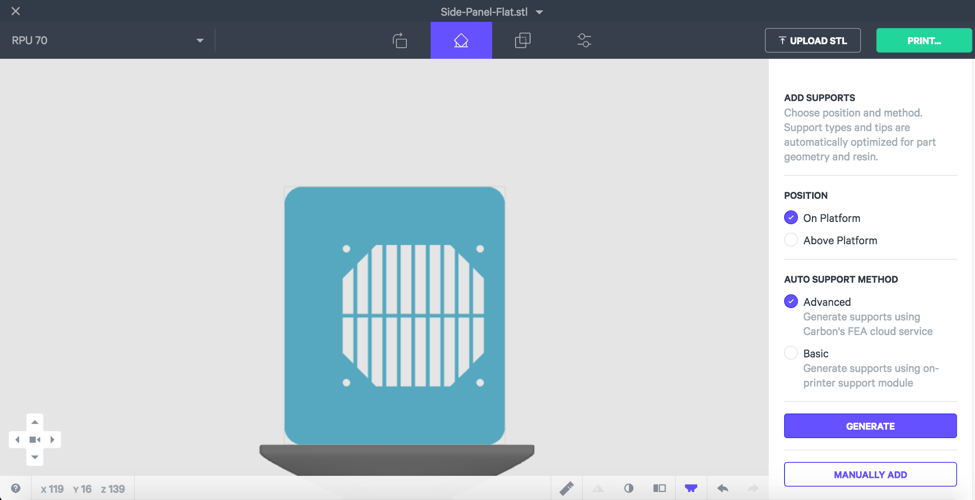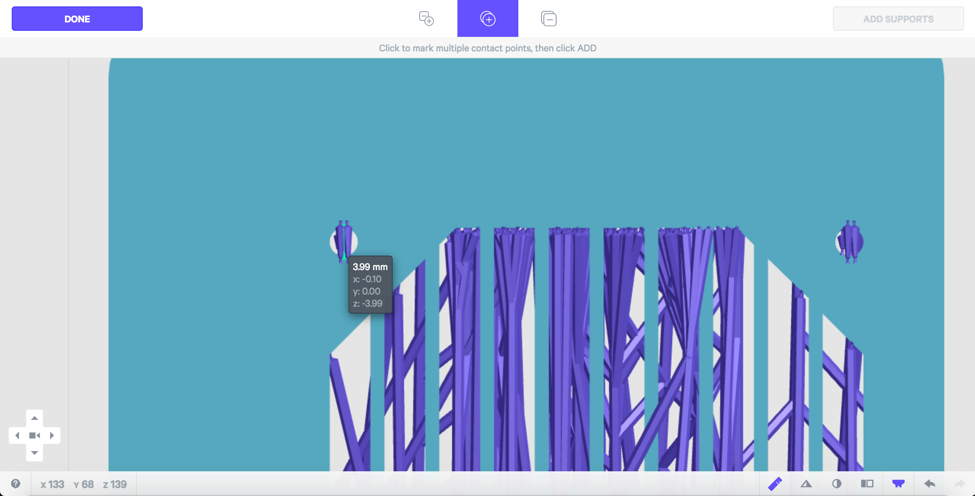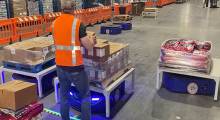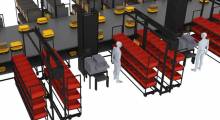People in the world of 3D printing/additive manufacturing (AM) tend to be passionate about their work. The best ones are those who see the big picture, knowing that AM is a stepping stone, and that the end product is what really matters.
 User-friendly interface for Carbon’s 3D-print system, showing support-creation options: generated automatically, either locally or via cloud-based simulation, or manually. Image courtesy of Carbon.
User-friendly interface for Carbon’s 3D-print system, showing support-creation options: generated automatically, either locally or via cloud-based simulation, or manually. Image courtesy of Carbon.Carbon is one of those companies that realize hardware, software and materials play equal roles in getting to that best-and-final result. Not only does it generate software updates every six weeks, it sees how simulation is crucial to getting the most out of each design iteration, fast. “Carbon’s software creates a digital canvas on which every cubic millimeter of a part can be designed, controlled, and optimized before it’s printed,” says Roy Goldman, director of software at Carbon.
Simulation Key to Orientation, Supports
Carbon’s latest software release offers three improved features, according to the company:- Advanced Auto Supports, which automatically generates a support-structure layout, finely tuned to minimize stress build-up;
- “Fence support” designs that attach at part edges, minimizing material usage and attachment-point artifacts; and
- Faster simulations with cloud-based resources, reducing simulation times from days to hours.
Kirby Freeman, Carbon software product manager, says the Advanced Auto Supports feature creates an optimized support-structure layout based on finite element analysis (FEA) of expected stresses as the part builds up. There are also manual support design-options (calculated locally on the printer) where users can choose either classic “bar” or newer “fence” type structures. All the tools can be applied on one part, so users can fine-tune as desired. “We encourage users to analyze many orientations of their parts to find the ones that meet their needs (e.g., lower stresses, cosmetic surfaces that are unsupported, ability to fit many parts in one build),” she says.
 Close-up of part (turquoise) prepared for 3D printing on Carbon systems, showing Advanced Auto Supports added (blue). Number, size and placement of supports determined using Carbon’s FEA-based simulation software. Image courtesy of Carbon.
Close-up of part (turquoise) prepared for 3D printing on Carbon systems, showing Advanced Auto Supports added (blue). Number, size and placement of supports determined using Carbon’s FEA-based simulation software. Image courtesy of Carbon.Clear, visual results showing the ready-to-print 3D part in the layout volume belie the sophisticated math and engineering taking place through cloud-based compute solution. Not only are the support structures derived from part geometry – such as height of a given point above the build platform – but also from the mechanical properties of the build material.
The FEA simulation uses a moving domain analysis to model Carbon’s Digital Light Synthesis (DLS) technology down to the micron level throughout the build process, then predicts potential warping and/or cracking. For a given part orientation, the software calculates where to place support bars or a fence-structure to counteract such problems. There’s no need for a user to understand meshing strategies, the green strength of the build-material or the physics of DLS itself.
The Bigger Plan for Digital Manufacturing
Carbon uses the phrase “dynamic tuning” to describe how the simulation process produces superior support structures for designs iterated over hours, not days. Users will see improvements in surface finish, greater precision at part edges, and savings in material consumption – all features that support 3D printing for real-world, full-scale production.“Intelligently derived support structures help, but they’re just the start of the story,” Freeman points out. “We’re racing to stay ahead of the products our customers want to make. The simulations are the bigger story; we know that the industry needs tools that focus not just on getting out one prototype, but that allow people to design new geometries and then iterate toward the accurate, cost-effective manufacturing of thousands of parts. This release is an important step towards bringing design and manufacturing-grade tools to the additive space.”
For another take on this news from Carbon, see “Carbon 3D Print Software Updated,” a DE’s Editor’s Pick of the Week.
About the Author
Follow Robotics 24/7 on Linkedin
Article topics
Email Sign Up
















